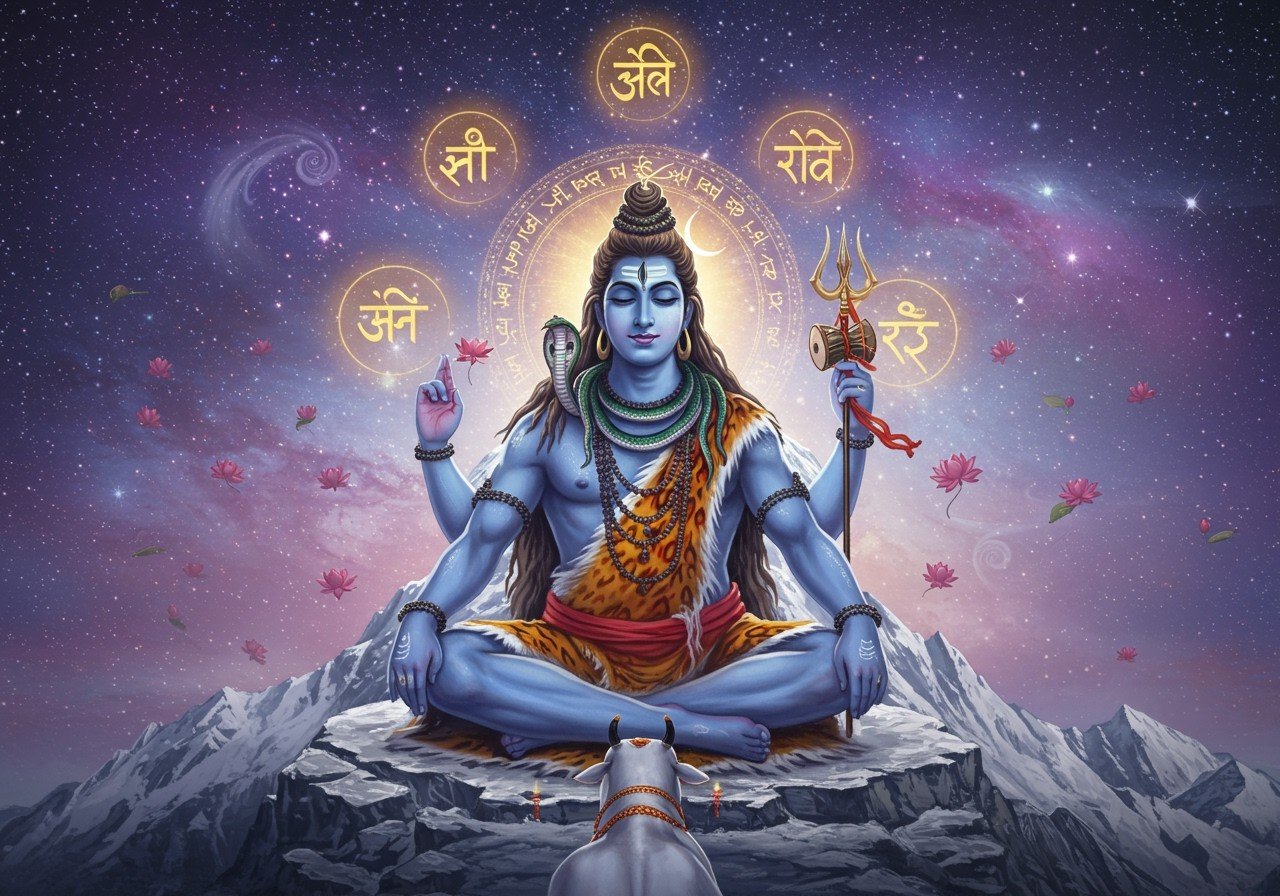
The sacred mantra “Om Namah Shivaya” is more than just a chant; it’s a spiritual voyage, a heartfelt tribute to Lord Shiva. Amidst our busy lives, this mantra offers a sanctuary of peace. Deeply rooted in ancient Indian scriptures, especially within Shaivism, it carries profound spiritual significance.
Each element of the mantra resonates with tradition and meaning. Om, the primordial sound, vibrates through the cosmos. Namah signifies “I bow to,” a gesture of reverence and surrender. Shivaya refers to Lord Shiva, the embodiment of the divine within each of us. Chanting this mantra encourages humility, dissolving the ego and paving the way to inner peace. This deeply resonates with many Indians who value their cultural heritage and spiritual practices.
Om Namah Shivaya in Hindi
Writing “Om Namah Shivaya” in Hindi connects us to a rich tapestry of tradition, especially for those engaging with Hindu rituals. Hindi utilizes the Devanagari script, commonly used in religious texts across North India. Here’s how it’s written:
- ओं (Om): Representing the universal consciousness, the source of all creation.
- नमः (Namah): A humble bow, an offering of respect and devotion to the divine.
- शिवाय (Shivaya): Invoking Lord Shiva, the auspicious one, the source of transformation and liberation.
Correct pronunciation of each syllable enhances the spiritual experience. Hindi’s prominence in religious hymns underscores its cultural importance within spiritual practices. You can find a beautiful collection of puja items for Lord Shiva on Poojn.in, helping you connect with the divine in your own home.
Om Namah Shivaya in Telugu
In the Telugu-speaking regions of Andhra Pradesh and Telangana, “Om Namah Shivaya” takes on a unique flavour. It’s written as:
- ఓం (Om): The primordial sound resonating through the Telugu heartland, connecting us to the divine.
- నమః (Namah): An expression of deep respect and surrender, offered with humility and love.
- శివాయ (Shivaya): Calling upon Lord Shiva, the benevolent force guiding us on our spiritual path.
Telugu plays a vital role in preserving traditions through local temples and vibrant festivals. The mantra is integral to the spiritual fabric of Telugu-speaking communities, reflecting their rich cultural heritage. Explore the devotion and culture of festivals across India and discover how they connect us to our spiritual roots.
Om Namah Shivaya in Kannada
Karnataka cherishes Kannada as a language of deep spiritual significance. “Om Namah Shivaya” in Kannada is written as:
- ಓಂ (Om): The universal sound, echoing through the ancient temples and landscapes of Karnataka.
- ನಮಃ (Namah): A heartfelt offering of reverence and surrender, deepening our connection with the divine.
- ಶಿವಾಯ (Shivaya): Invoking Lord Shiva, the source of wisdom and strength, guiding us towards enlightenment.
Home to many ancient Shiva temples, Karnataka holds Kannada in high regard for its historical and religious importance. The language plays a central role in cultural rituals, transmitting the mantra’s spiritual essence. Discover the sacred power of water in temples and rituals, a vital element in connecting with the divine.
Om Namah Shivaya in Tamil
Tamil Nadu, a region deeply rooted in Shaivism, expresses “Om Namah Shivaya” in its distinctive script:
- ஓம் (Om): The primordial sound, echoing through the rich tapestry of Tamil spiritual tradition.
- நமஃ (Namah): A humble offering of respect and devotion, resonating with the heart of Tamil spirituality.
- சிவாய (Shivaya): Invoking Lord Shiva, the divine force revered in Tamil Nadu’s ancient temples and scriptures.
Tamil literature has long preserved the teachings of Shaivism, integrating the mantra into worship and religious ceremonies. Understanding its Tamil form highlights the language’s profound contribution to spiritual practice. Preparing for Maha Shivratri? Find essential puja items and guidance on Poojn.in to make your celebrations truly special.
Cultural Variations and Interpretations
Across India, “Om Namah Shivaya” finds diverse expressions. Different regions have unique chanting styles and ritualistic applications. Within Shaivism itself, interpretations vary, yet the mantra acts as a unifying spiritual thread.
Regional festivals and temple traditions weave the mantra into their celebrations. Understanding these variations enriches our appreciation of India’s vibrant spiritual heritage. Enhance your spiritual journey with authentic murtis and puja essentials from Poojn.in. We offer a wide selection of Shiva murtis, brass trishuls, and other sacred items to enrich your devotion.
Conclusion
“Om Namah Shivaya” transcends languages and regions, uniting us in devotion to Lord Shiva. Whether written in Hindi, Telugu, Kannada, or Tamil, each script carries the same profound meaning. This mantra guides us on a path of humility and peace, connecting us with the divine and the rich tapestry of Indian spirituality.
Exploring the variations in each language enhances our spiritual practice. As we delve into its many forms, we remember the essence of “Om Namah Shivaya”—a journey to inner peace and a tribute to the divine within. Online resources offer convenient access to deeper understanding, helping us honour traditions passed down through generations. Elevate your spiritual experience with sacred songs and mantras available on Poojn.in, creating a sacred space in your home.


